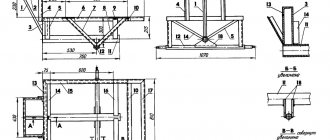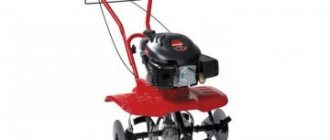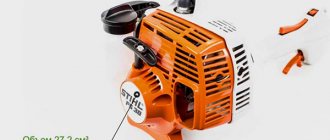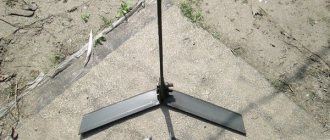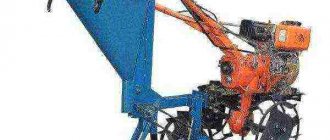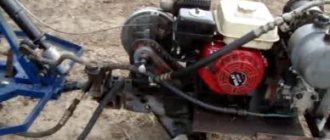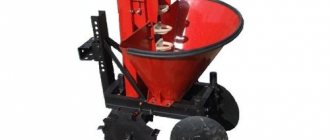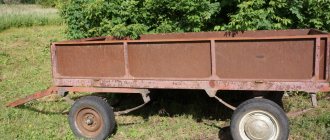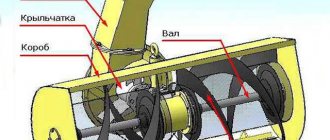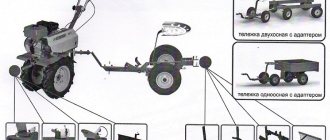Making an adapter for a walk-behind tractor with your own hands
At the moment, there are several types of adapters, as a rule, their designs are similar, and are a device attached to the back of the walk-behind tractor with a comfortable seat.
The adapter is made of a square metal profile, 160 to 180 cm long. Across this profile, another one, 50-60 cm in size, is welded, depending on what track you need (wheel stands are attached to it). The height of the racks to the wheel axle from the top to the adapter wheel axle can be from 25 to 40 cm, depending on the design.
Next, braces are welded to the main metal profile and wheel bushings; they also serve as stiffeners. Their length depends on the angle of inclination relative to the entire structure and other parameters. Then, the frame structure to which the attachments will be attached is calculated and welded. The side guides of this design are attached to the wheel stands with bolts.
After this, a control lever with three bends with dimensions of 35, 55, 20 cm is welded to the main frame. To increase the applied force, another lever is attached to the lever, but with dimensions of 80 cm.
The adapter seat is mounted on a support welded to the central metal profile. As you can see, making an adapter for a walk-behind tractor with your own hands is not so difficult.
Purpose of the adapter
Here, I think everything is clear, there is a fairly large amount of work on the ground that is easier, faster and more convenient to do with an adapter. And working with such attachments as a tiller is generally safer.
Design diagram of the adapter for the walk-behind tractor
The adapter for a walk-behind tractor is a kind of towed device made on a frame and having two wheels. Structurally, adapters are divided into several types; in simple terms, they can be simple or more complex. The main types are considered universal, those that are capable of transporting loads and performing soil cultivation, and simple ones, capable of only performing soil cultivation.

For walk-behind tractors of different power, different adapters are used; for a low-power one, an adapter with a short drawbar is installed, for a powerful one, with a long one. Also, universal adapters are equipped with additional functionality, increasing the track, lifting attachments, etc.
Design and principle of operation
Essentially, the adapter is presented in the form of a trolley that is attached to the walk-behind tractor. After which the structure turns into a mini-tractor. The main details of such a unit:
- a frame to which other constituent elements are attached;
- driver's seat with lift lever;
- 2 wheels;
- clutch device;
- wheel axle.
In this video we will analyze the front adapter:
It is one of the most important elements of the device, since other elements are connected to it. Therefore, it must be made of high-quality and durable materials.
Driver's seat
One of the main advantages of the adapter is a comfortable seat for the operator.
Wheels
There are 2 types of wheels available - metal and rubber. The former are used for heavy types of work in the field. The latter are designed for driving on dirt roads.
Clutch device
The hitch is responsible for connecting the attachments and the mechanical unit itself. This fastening is defined as one of the most important, therefore it is made of high-strength metals - steel or cast iron.
The length of such a device is about 2 meters, width – 80 centimeters.
Depending on the clutch, the following design options can be considered:
- with movable clutch. This device is the lightest. The clutch here is located in the front, but control in this case is more difficult, since it is necessary to deploy the entire power unit;
- with steering. The clutch here is rigid, and control is achieved through a mechanical steering unit. This control is easier to use, but more difficult to produce.
There are different adapters for walk-behind tractors of different performance. For mechanisms with low power - with a short mount, for powerful ones - with a long one.
Do-it-yourself walk-behind tractor adapter, drawings and dimensions
Below are the drawings and dimensions, as well as the materials required for the manufacture of an adapter for a walk-behind tractor of complex design.
What you will need to make the adapter
— Metal sheets for footrests
- Square metal. Profile
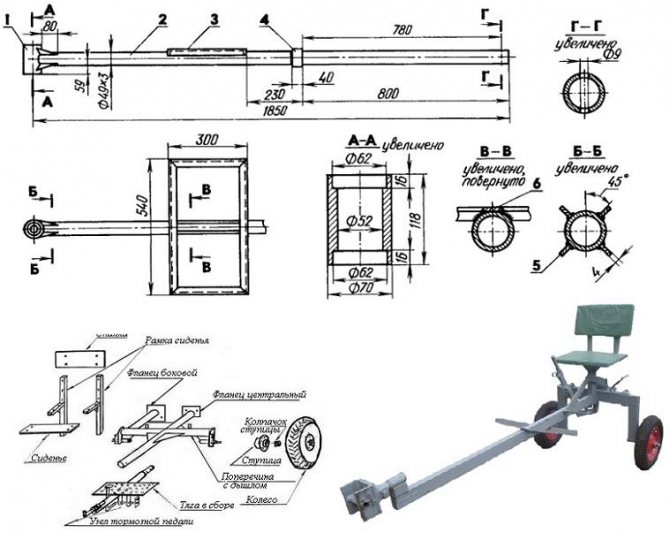
Below is a kinetic diagram that will help ensure the balance of the structure and avoid additional load. The drawing below shows the diagram of a mini tractor made from a Neva walk-behind tractor.
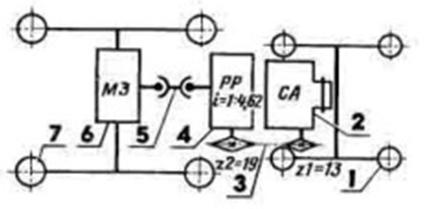
The engine of the power unit (2), driving the front wheels (1), transmits torque through the chain (3) to the reverse gearbox (4), and from it, through the cardan transmission (5) to the rear axle (6), driving rotation of the rear drive wheels (7).
— When making the frame, you must not forget about the arrangement of the bushing and fork to ensure free rotation of the trailer.
— The body of the adapter to the walk-behind tractor is made of steel sheet, and the sides of the body must be at least 30–35 cm high.
— The seat is installed on a beam welded to the main frame using bolts. The distance from the beginning of the frame to the seat should be 80-90 cm.
— Checking the robotic capability of the entire mechanism.
Additional simple adapter drawings
Below is a drawing of one of the simplest adapters in terms of design.
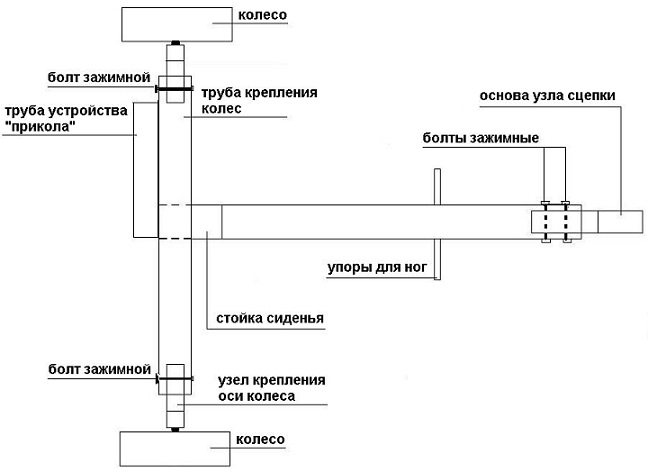
The following are welded to a frame made of square profiled pipe measuring 50*50 mm and thickness 2 mm:
— Footrest in the form of a perpendicularly installed pipe;
— A stand with a seat installed on it;
— Square pipe of the same cross-section for installing wheels;
Drawings of key adapter components
Hitch mechanism
. It looks like a welded structure inserted into the main frame and secured with bolts. It consists of two sections of a square pipe welded onto each other and a section of a regular “water” pipe with a caliber of 1-1.5 inches.
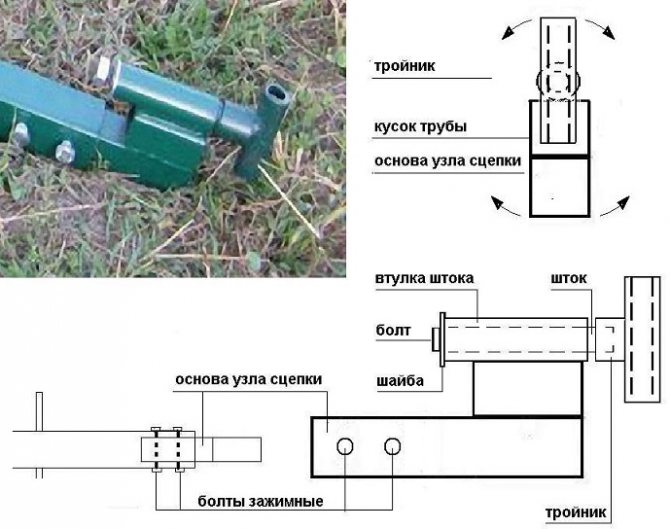
A rod with a welded homemade tee is inserted into the pipe, not fully inserted, clamped with a bolt. The rod is lubricated with grease and ensures that the tee rotates along the axis to ensure a rolling effect when moving on uneven ground.
Wheel mount
. The design consists of two pipe sections welded perpendicularly. The horizontal section is inserted into the mounting pipe and fastened with a bolt. An axle with a wheel is mounted on the vertical part (on bearings).
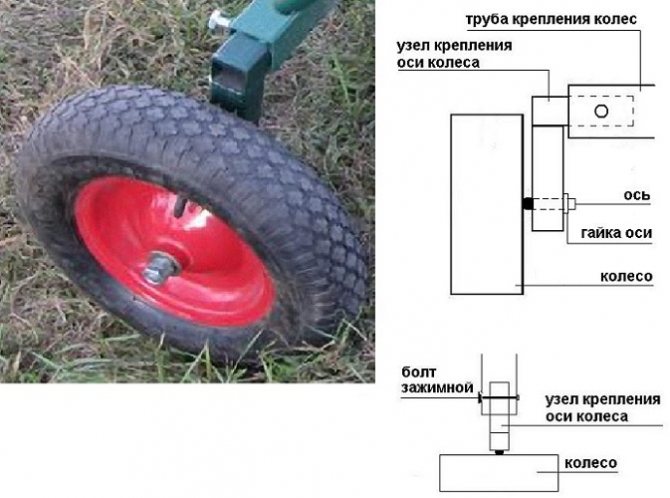
Other adapter components are not so important, and we will not consider them.
Adapter for walk-behind tractor Neva
Drawings and dimensions for different walk-behind tractors may vary depending on the design. So for popular models of walk-behind tractors Neva, MTZ, OKA, homemade adapters can differ significantly.
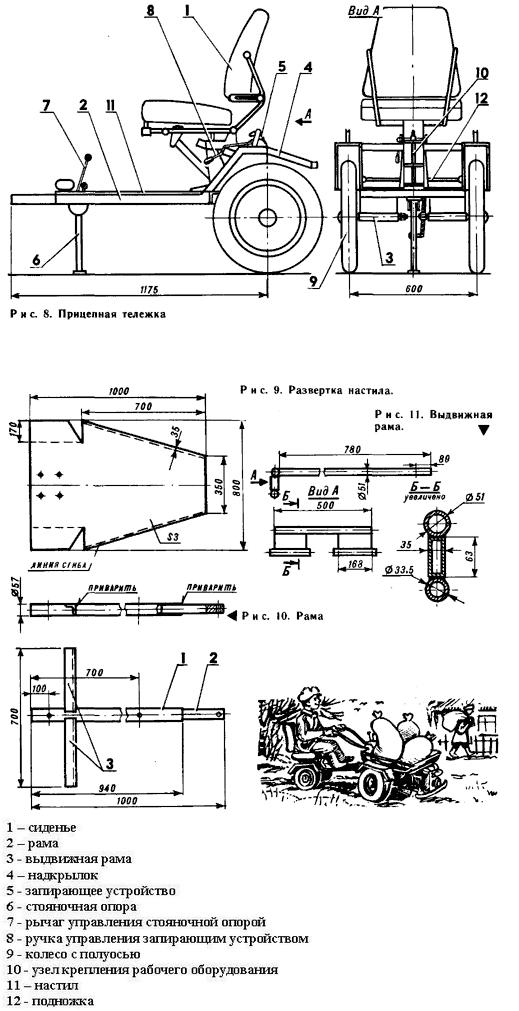
By making a homemade adapter for a walk-behind tractor and using various types of attachments with it, you can not only make your work easier, but also significantly increase productivity.
Manufacturing a device with a movable joint
This is the simplest device. The adapter itself will be located behind the walk-behind tractor. It is not difficult to make, but the process requires attention and concentration. The service life of the mechanism depends on the quality of work. This adapter is suitable for heavy walk-behind tractors, for example, “Neva”. It has an engine power of over 7 hp. With. and weight from 105 kg. This allows you to pull not only the adapter, but also agricultural implements without slipping.
For manufacturing you will need the following materials and tools:
- electric drill with the necessary set of drills;
- DC welding machine and electrodes;
- grinder with a set of cutting and grinding discs;
- hammer, file, square, various hardware;
- sheet metal with a thickness of at least 5 mm;
- several profile pipes measuring 40 x 50 and 50 x 50 mm;
- round water pipe with thick walls with a diameter of 30−45 mm;
- steel rods with a diameter suitable for a round pipe;
- channel 40 x 50 mm;
- two wheels from a Zhiguli or Oka with bearings and hubs;
- driver's seat.
You can choose any adapter size, but based on the needs of the mini-equipment. The frame itself can be made slightly higher or lower than the axis of the walk-behind tractor. For wheels, the optimal suspension is portal, providing decent ground clearance. It is not necessary to install shock absorbers on the adapter - this complicates the design. The easiest way is to take a seat with built-in elastic elements.
Next, they proceed directly to the manufacture of individual components.
- Hitch. This is a welded mechanism, which is a hinge that operates in two planes. It is then installed into the base of the adapter frame and bolted to it. It consists of two pieces of 40 x 50 pipes welded to each other and a piece of round water pipe. A welded tee is inserted into it. The tee itself consists of a rod and part of the same pipe. This is the most critical unit, so the welds must be perfect.
- Adapter frame. Here you will need a profile pipe and channel. They are welded together, strengthened, and then made into racks for the wheels. Next, the racks are fixed with braces welded to the frame and wheel hubs. Install and secure the wheels.
- Several pieces of pipe are welded to the main frame to install the seat.
- Fix and adjust the seat. It is placed so that when the steering wheel is turned, the operator’s back does not leave the backrest. There is no need to remove the walk-behind tractor controls - this is done when the power plant is located behind the driver.
- Install the finished coupling device.
- Attached to the walk-behind tractor.
Next, the wheel locking mechanism is made. To do this, use a ready-made brake system from any passenger car and fit it to the installed wheel hubs.
What types of adapters for walk-behind tractors are there?
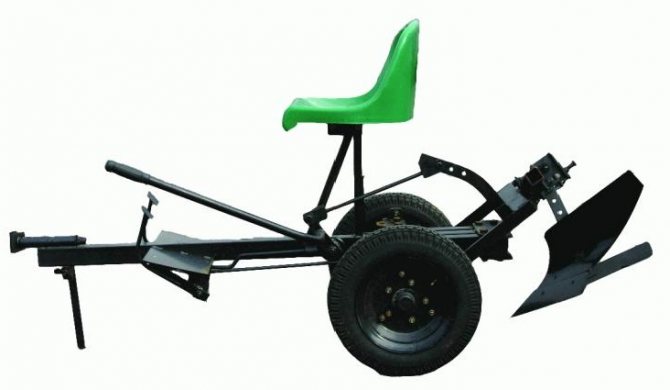
By equipping a walk-behind tractor with such a “new thing”, you will actually turn it into a mini-tractor - working will become much more convenient, faster and easier, and the ability to adjust the seat will make the work process more comfortable. There are several types of adapters for walk-behind tractors. In order to buy or make the most suitable option for you, you should familiarize yourself with all types of this equipment.
Based on the type of clutch, adapters are divided into adapters with steering and movable joints. Depending on the location - on the front adapters and rear ones.
Adapters can also be classified into a separate classification based on the purpose of use: with an extended drawbar for powerful large walk-behind tractors, with a shortened drawbar for small, lightweight units.
Adapter with steering
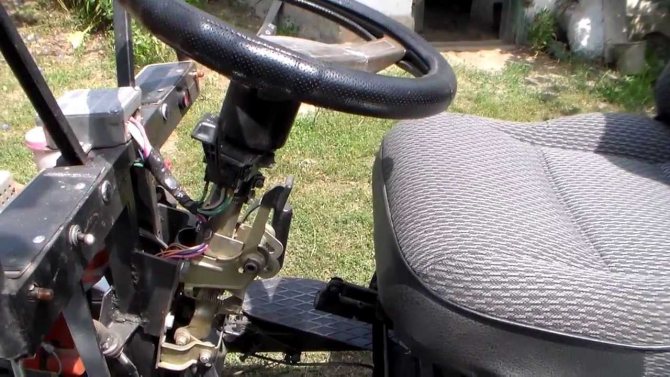
This type of adapter will turn your walk-behind tractor into a fully-fledged, comfortable vehicle. The adapter is in close contact with the walk-behind tractor itself and is securely connected to it. Wheels can be located both at the back and at the front of the structure.
Movable joint adapter
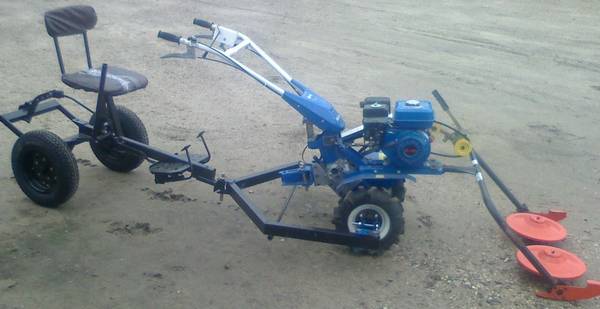
This type of adapter has its undeniable advantages - it is easier to manufacture, you can easily adjust the angle of inclination relative to the walk-behind tractor. The downside is that it is a little harder to control, the turning radius increases when maneuvering, and you need to put in more effort.
Front and rear adapter
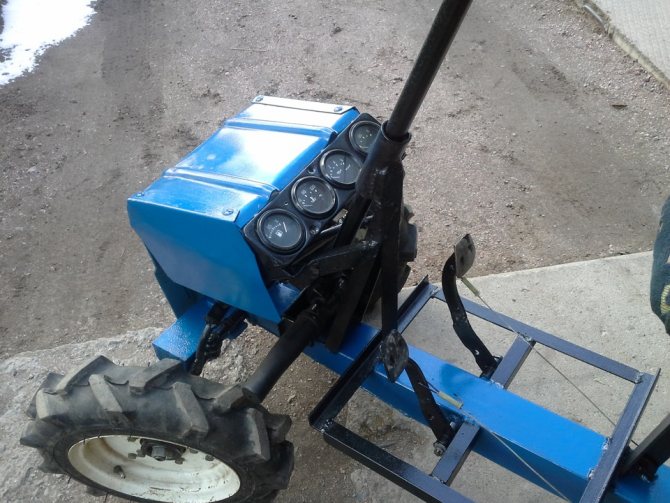
The classification accordingly depends on the location of attachment. The choice of this type of adapter depends purely on the individual preferences of the owner of the equipment and the work to be done. For example, a front adapter is more suitable for plowing and cultivating because the attachment does not need to be constantly monitored during these operations. But when hilling beds, a rear adapter would be more appropriate, which will allow you to conveniently monitor the work process.
How to make an adapter for a walk-behind tractor with your own hands?
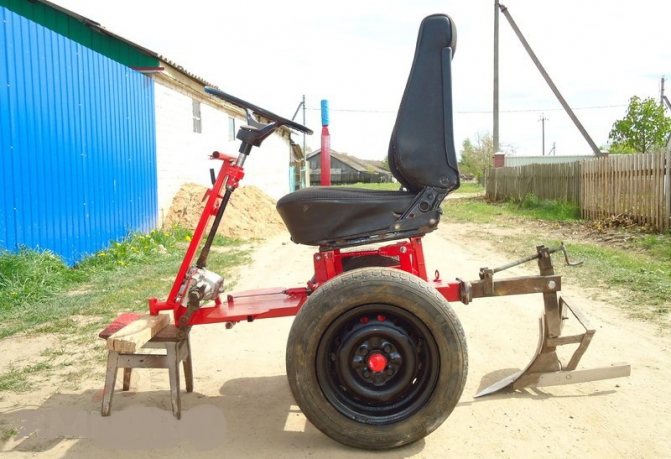
It will be enough to think through the drawings and dimensions, acquire some materials and the appropriate set of tools. The required minimum of accessories for self-assembly of an adapter for a walk-behind tractor is as follows:
- metal corners;
- square metal profile;
- 2 wheels of suitable size;
- welding;
- dense sheets of metal (for support under the feet);
- small hand tools (screwdriver, saw, tape measure, etc.).
We have already given a general idea of what the adapter should look like at the beginning of the article. Now let's take a closer look at the other main elements of its design.
- Frame. The main component of future equipment. The design of some adapters allows for integration with a walk-behind tractor into one unit, but such an adapter requires reconstruction of the walk-behind tractor itself (a new stand for the engine will be needed).
- Suspension.
- Hitch. Provides stability and reliability of the entire structure. The type of coupling device should be taken into account depending on the type of adapter. If the adapter is with the steering wheel, the hitch must be rigid. With a movable joint, the hitch must be rotatable, on a horizontal hinge.
- Sitting. The finished product is created or selected based on the designer’s preferences.
- Control system. Suitable for rigid coupling. You can also cook it yourself or buy it.
The drawings below show in detail the dimensions of the adapter structure, as well as its main connecting units.
How to make a front adapter with your own hands
If you have minimal skills in working with simple tools, as well as the ability to use a drawing, you can easily make a homemade adapter, like a KTZ for a walk-behind tractor.
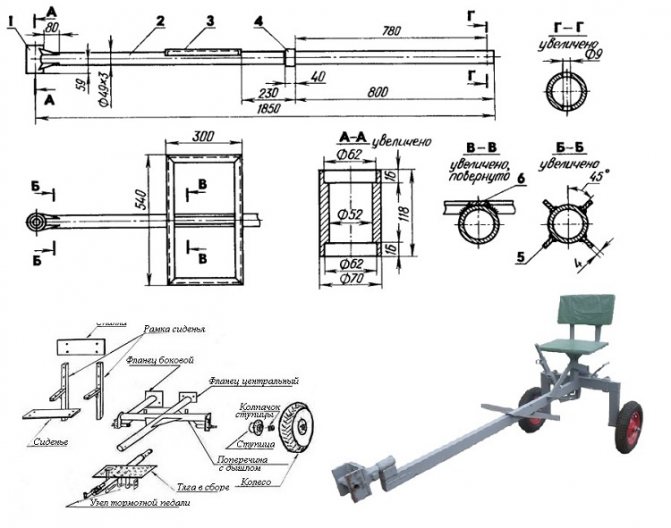
Device
The main parts of such a unit are:
- Frame.
- Operator's workplace.
- Suspension, which can be bridge, axial, portal, or rotary.
- Steering with rigid coupling.
Due to the front location of the device, there is a place for mounting the blade on it (if the rear version is used, then a portal is created on it for using attachments).
The most important element of such a design is the coupling device, which is necessary to ensure high-quality fastening of the adapter to the walk-behind tractor itself. It also provides the required level of stability for future four-wheeled vehicles. The ability to move the steering mechanism forward is provided by a rigid coupling. If the section angle of the rotating device changes, it is necessary to ensure horizontal fastening of the hinge.
Manufacturing process
The procedure for constructing a homemade adapter is as follows:
- It is created independently or a ready-made kinematic scheme adapted for a specific option is used. The most important condition here is to ensure the correct balance of the future structure.
- After this, the main frame is assembled. It is manufactured on the principle of a fork with a bushing to allow rotation.
- Wheels with a steering mechanism are connected to the front part, and a mount is also created to which the blade will be connected in the future.
- A seat is mounted on the frame, next to which a mechanism with remote control of the walk-behind tractor is installed.
- At the end, the entire structure is checked and tested to identify faults or various shortcomings.
Before use, it is recommended to paint all metal parts to protect them from rust.
The use of adapters for walk-behind tractors allows you to turn them into a full-fledged mini tractor, thereby significantly expanding the range of their applications. In addition, the performance and usability of the device increases. Such units can be purchased ready-made for specific walk-behind tractors or assembled independently, having previously prepared a diagram-drawing.
Step-by-step assembly of the adapter
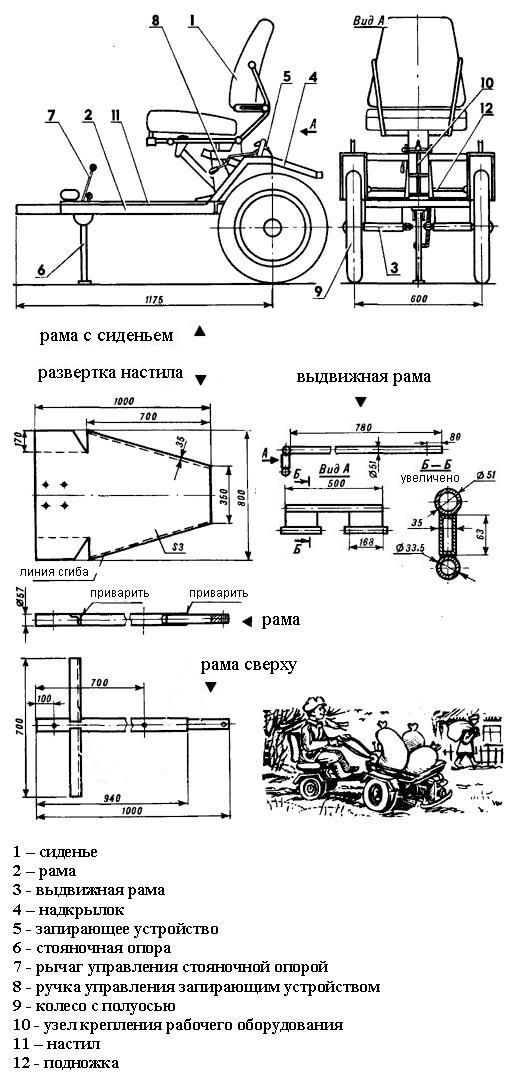
After the necessary drawings and dimensions of the parts have been thought out, the material has been found and the tool has been prepared, you can proceed directly to assembling the adapter.
- We weld a metal profile about 60 cm long perpendicularly to a section of a square metal profile about 180 cm long. It is this section that will be the mount for the wheels. Wheel stands must be at least 30 centimeters high.
- We weld the braces to the main frame and wheel hubs.
- The dimensions of the main frame will be about 40x40 cm, they can vary depending on the individual wishes of the designer. Channel No. 10 is welded to the rear edge of the frame. The side pipes are fastened with reliable bolts.
- Then the control lever is welded to the frame. To increase the control effort, the lever may have one or more elbows about 70-80 cm long. The elbows are bolted together.
- As a stand for the seat, you can use a pipe about 30–40 cm long, which is securely welded to the main frame.
- We weld the hitch to the walk-behind tractor.
We also invite you to watch the video, which demonstrates various types of adapters and their features for walk-behind tractors of several well-known brands.
Firework:
MTZ:
Agro:
Forza:
How to make your own all-wheel drive adapter for the Neva walk-behind tractor
Of course, purchasing a ready-made adapter for the Neva walk-behind tractor is the simplest and best way out of the situation. However, they cost quite a lot, so not every summer resident or farmer can afford to purchase them. It is not surprising that many people ask the question - how to make an adapter for the Neva walk-behind tractor?
There are quite a lot of recommendations on the network regarding the manufacture of adapters, as well as many drawings that allow you to see this device in more detail. Using them, it is quite possible to make such a unit at home, using the bare minimum of materials and tools.
What you need to make a homemade adapter
To make a homemade adapter we will need:
- pair of wheels;
- steel angles, iron sheets and pipes;
- driver's seat;
- welding machine;
- fastening connections, etc.
A do-it-yourself adapter for the Neva walk-behind tractor, drawings of which will be presented later, can be made using this minimal list. Before proceeding directly to the manufacture of the device, you need to draw its diagram.
It should provide for the degree of load of different parts of the frame, as well as the overall dimensions of the device. You can do this yourself, or you can use the drawings of those who have already successfully assembled a homemade adapter.
Let's move on to manufacturing the structure. Let's divide all the work into several main steps:
- We will need a square metal profile , the length of which should be approximately 1800 mm. Across this profile you need to weld such a piece, but of a smaller size - about 600 mm. The wheel stands will be attached to this piece of profile.
- The height of the racks should be about 300 mm.
- Next you need to weld the braces. They are welded to the main frame, as well as to the wheel hubs. The angle of their location relative to the frame can be made at any angle at your discretion.
- Additionally, we weld a beam to the metal profile. This is needed to strengthen the frame.
- The frame structure for the attachments is welded from channel number 10. It is connected to the wheel axle with a piece of square pipe, and the seams are welded.
- Next, we weld a control lever with three bends to the frame. Accordingly, these are 350, 550 and 200 mm. We attach to this lever another one measuring 800 mm, which will regulate the force. The levers are connected to each other with ordinary bolts.
- We weld a piece of pipe approximately 300 mm long to the main frame - this will be our seat stand. At the top we also weld two pieces of pipe perpendicular to this stand. This is necessary so that the seat is more stable and does not come off during operation.
- The seat can be taken ready-made , or made from a piece of plywood, then covered with foam rubber or other soft material. The seat is attached to transverse pieces of pipe welded to the stand under the seat, as well as to the stand itself. We use regular bolts as fasteners.
- At the front you need to weld the coupling mechanism to the walk-behind tractor.
As we can see, the work is quite simple, but you will need skill in working with a welding machine, because... There is no other method of connecting all the components.
You can complicate the design a little by making a homemade adapter for the Neva walk-behind tractor, which will have steering control . For this we need:
- iron sheets;
- steel pipes and angles;
- seat;
- a pair of wheels;
- welding machine.
In this case, the adapter frame must be well articulated with the walk-behind tractor so that the structure does not move to the sides. As a steering wheel, you can take a ready-made one from old Soviet cars (for example, from a VAZ).
Making an adapter for a walk-behind tractor with your own hands
Any activity on a plot of land takes a lot of time and effort. For this reason, gardeners are increasingly using special equipment, such as walk-behind tractors. However, it is impossible to do everything with this unit. Without a special adapter, you will not be able to weed or hill up the ground, or clear the area of snow and construction debris. A cart with a seat for a walk-behind tractor nowadays costs quite a lot of money. However, there is a way out. Today we will talk about how you can make a homemade adapter for a home walk-behind tractor without any special effort.
Description of the adapter for the walk-behind tractor
The adapter is a special module for moving on a walk-behind tractor. With its help, you will be able to operate the unit in a sitting position and at the same time cultivate the land. For example, the adapter for the MTZ walk-behind tractor has steering control. It is quite possible to do it yourself. One of the sections of the article below is devoted to how this can be done. In the meantime, let's talk about the purpose of this attachment.
Using an adapter can greatly simplify the use of this home appliance. You will have the opportunity to change attachments for hilling or planting potatoes, a flat cutter, a plow and other devices. The adapter also speeds up absolutely any garden work . In other words, if such a device is used in practice, the speed of the workforce will increase from 5 to 10-11 km/h.
General information about the tractor
The walk-behind tractor can be used separately, as well as connected to a wide variety of additional equipment, such as:
Such devices can significantly increase the possible range of work that a walk-behind tractor can handle. In addition to this, you can use a mini-tractor as a means of transportation if you prepare a special block adapter for it in advance.
This device makes it possible to sit quite comfortably on the seat with which it is equipped, and then perform exactly the same work, but with an incomparably greater degree of comfort. For example, in specialized stores you can purchase an additional unit with steering control for the Neva walk-behind tractor, or you can make it yourself. Fortunately, there are plenty of drawing materials on the Internet, which greatly simplifies the assembly process.
Adapter design features
This attachment includes:
- frame;
- driver's seat;
- a pair of wheels;
- wheel axle;
- coupling device.
That is, the adapter gives the impression of a cart that is attached to the main equipment. As a result, it looks like a mini tractor.
Now let's talk about each component in detail.
- To make a front adapter for a walk-behind walk-behind tractor with your own hands, a frame is required. The body or driver's seat is attached to it. The frame is mounted on the chassis.
- For ease of use, a driver's seat is attached to the frame. This is designed to make it pleasant and easy to operate the equipment during gardening work.
- The wheels and axle make it easier for the operator to garden with this small tractor.
- There are two types of wheels for a home tractor - rubber and metal. Metal wheels can be used for reliable work in the fields. Rubber wheels are equipped with a deep tread pattern. This way they can allow the operator to move the unit on unpaved roads and, if necessary, off-road. In any case, the wheels for the adapter are supplied with the purchase as part of the equipment itself. But if the user wants to change them, you need to pay attention to their type and size.
- Device for coupling (fastening) with a walk-behind tractor. The mount for the MTZ unit is made of steel or cast iron, using welding. The hitch is one of the essential components of the units. It provides a reliable connection to the part with the motor of the trailed equipment. The U-shaped attachment point is considered the most commonly used, because thanks to this device the vehicle is more stable.
Walk-behind tractor dimensions
Walk-behind tractors can be divided into two classes:
- lightweight, engine power up to 6.5 hp;
- heavy - over 7 hp
The weight of walk-behind tractors, regardless of class, is at least 60 kg and can reach up to 300 kg.
Standard sizes are the following:
- length - 174 cm;
- width - 65 cm;
- height - 130 cm;
- track - 32 cm;
- ground clearance - 14 cm;
- the smallest turning radius is 110 cm.
To design a homemade adapter for a walk-behind tractor, no special education is required, it is enough to rely on the recommendations of professionals and drawings, and have welding skills
Necessary tools and materials for work
All necessary materials and tools, which are low in cost, can be easily purchased at construction shopping centers. In order for the work on making the adapter to be effective and continuous, you should first prepare everything you need:
- a pair of wheels with an axle on which they are mounted;
- chair ready or for its manufacture: frame, covering material and filling;
- metal profile for frame, corner;
- steel circle with holes for making a coupling device;
- bearings to support the axle;
- fasteners;
- lubricants, primers, painting products;
- welding machine;
- lathe, grinder and drill.
Drawing
Main design elements:
- frame;
- suspension;
- portal for rear adapter;
- hitch;
- sitting;
- steering.
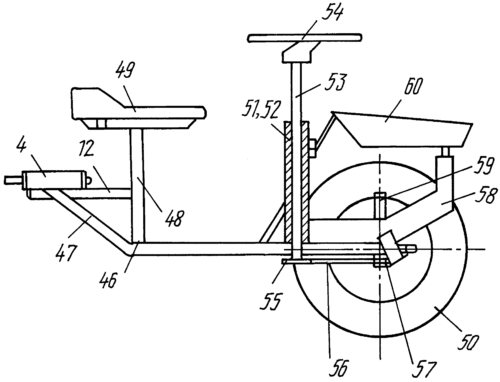
Instructions for making the adapter
Now we’ll tell you how to make a front adapter with steering for your small tractor yourself.
To produce an adapter for a walk-behind walk-behind tractor, you will need the following materials:
- Two identical wheels on an axle. The radius of the wheels ranges from 15 to 18 inches. Even wheels from an old Soviet Volga might work.
- Bearings for steering wheels and columns.
- Steel for the frame (channel, pipe or angle).
- Fastening elements (washers, bolts, nuts).
- Lubricants (litol or grease).
- Consumables (drills, electrodes, discs for grinders).
- Set of wrenches.
- Bulgarian.
- Welding machine.
- Drill.
Before starting work, it is important to consider that the wheels should not have a very large or small radius.
Algorithm of actions
We begin to manufacture attachments for the walk-behind tractor.
First of all, you will need drawings, in accordance with which all parts will be fastened and manufactured.
a drawing of the adapter circuit for a walk-behind tractor from MTZ yourself, especially if you have the proper skills.
If you are afraid of making an error in your calculations, you can refer to materials on the Internet on specialized sites or forums. Based on them, according to reviews and practice, it is quite possible to independently make the most simple adapter for a walk-behind tractor. Important! Before you start working on the drawings, be sure to check the compliance of the dimensions and numbers.
To make a steering adapter for a walk-behind tractor, you will need a frame with a bushing and a fork. This will ensure free rotation of the walk-behind tractor using the steering wheel .
- Everything will start with making the frame. It can be done from cut pieces of selected steel of the required length. The metal can be separated with a grinder and the elements can be fastened with electric welding or bolts.
- Next we build the chassis. If the motor of your walk-behind tractor is located in front, therefore, the track size must be determined by the main wheels. The rear ones are mounted to the frame using an axle. It can be created from a piece of pipe of suitable width. At the ends of this pipe we press bearings with bushings. The wheels will be installed on them. If the walk-behind tractor engine is located at the rear, then the track width must be larger, otherwise the minitractor will not be able to move normally during operation. In such a situation, it would be best to remove the base wheels of the walk-behind tractor and reinstall it, but on a more spacious axle.
- To make a steering wheel for the unit, you do not need to additionally remove the handles from the car or motorcycle. Stop using the handle. In other words, the operator will have the opportunity to control the minitractor with a steering wheel that looks like a motorcycle. However, with it the operator will not be able to reverse normally. That is why it would be preferable to mount the steering column on a mini tractor.
- When using an all-metal frame, the steering will be integrated with the front axle of the walk-behind tractor. You can make an articulated support, then the control column will rotate the entire front half-frame. To do this, the technician will need to attach a gear to the front half frame. The second gear is installed on the steering column.
- The seat, which can be previously removed from a passenger car, must be welded to the frame of the slide. The technician needs to make sure that it is adjusted, especially when controlling the front adapter attached to the walk-behind tractor.
- If you intend to use the minitractor to work with plows and cultivators, then you will need additional welding of the bracket. An auxiliary hydraulic system must be installed to operate the attachment. The pump for it can be easily removed from agricultural machinery. If you have to work with semi-trailers, then you need to take care of additional welding of the towbar to the rear of the frame. It can also be successfully borrowed from a passenger car.
- You can do the fastening (coupling) yourself. To do this, you will need drawings, which are easily found in articles based on the top results of the desired topic. And we will talk about how exactly to carry out the coupling.
To make a U-type hitch, you will need a metal channel of suitable thickness and size. The hitch is attached to the walk-behind tractor under the steering column through pre-drilled holes in certain places. The bracket and pins are inserted into them. It is important to ensure that the parts are of high quality, this will avoid unnecessary problems in the future and wasting time in the present.
All parts must be made from high-quality high-strength steel. This completes the installation of the front adapter on the Neva walk-behind tractor. After completing the assembly, all that remains is to lubricate the minitractor and check it for functionality. After this, the adapter assembly can be assessed as complete. Now you can safely carry out the required work on land using new equipment.
How to make it yourself
Of course, purchasing a ready-to-use adapter for a walk-behind tractor is the best and easiest way out of the situation.
With all that, they really cost quite a lot, so not every farmer or just a summer resident is ready to afford to purchase them. It’s no wonder why many people wonder how to make an adapter with their own hands. This is, of course, possible, and you can find quite a lot of recommendations on the Internet that relate to making adapters yourself. Moreover, there are many drawings that make it possible to examine this device more clearly and in detail.
Using them, it is quite possible to create such a unit at home, using a minimum of tools and materials. To produce a homemade adapter you will need:
- welding machine;
- pair of wheels;
- steel angles and sheets;
- driver's seat;
- fastening connections; iron pipes.
Before work on the manufacture of the device begins, it is necessary to at least generally consider the finished circuit. It must take into account and indicate the load levels for various parts of the frame and the overall dimensions of the device. Now you can proceed directly to the production of the structure.
All work will consist of several steps:
- We take a square metal profile, approximately 1800 mm long. We weld the same piece of iron across it, only smaller in size - approximately 600 mm. Wheel stands will later be attached to this profile sheet, the height of which should be about 300 mm.
- After this you need to attach the braces. They are attached to the central frame and to the wheels. The angle of the wheel hubs relative to the frame is allowed to be whatever you want. A beam is additionally welded to the metal profile. This is necessary to strengthen the frame.
- The frame for additional equipment is welded from channel No. 10.
- It is combined with the wheel axle using a piece of square pipe, and the seams are welded with a welding machine.
- Now we weld a control lever with three bends (200, 350, 550 and millimeters) to the frame.
- We attach another one to the lever (size 800 mm), it will regulate the force.
- The levers are connected to each other with ordinary bolts.
The first stage has been completed. Let's move on to the next one.
Working with the adapter design
Now it starts working with the adapter . To do this, perform the following steps:
- A piece of 300 mm pipe needs to be welded to the central frame - this will be a stand under the driver's seat.
- On top, perpendicular to this stand, we weld 2 pieces of pipe in the same way. This is required so that the seat does not come off during operation and is more stable during shaking during operation. The seat can be ready-made, or you can make it yourself from a piece of plywood and foam rubber, this is at the discretion of the master.
- We attach the seat to transverse pieces of pipe, which we weld to the stand itself, as well as to the stand under the seat. We use ordinary bolts as fastening elements.
- We weld the coupling mechanism to the walk-behind tractor at the front, after which the work can be considered complete.
As you can see, this matter is quite simple. The main difficulty lies only in the need to have at least basic skills in working with a welding machine, since there is simply no other method of connecting each component.
Adapter with steering
If you have the skills, then, if desired, the design can be somewhat complicated by making a homemade adapter for the walk-behind tractor, to which you can also attach a steering control.
To implement this idea , you will need to prepare the following materials and tools:
- welding machine;
- seat;
- 2 wheels; steel pipes and angles;
- iron sheets.
With this design, the adapter frame must be firmly connected to the walk-behind tractor, otherwise the device will, as they say, “drive to the sides.”
For the design, you can take any ready-made steering wheel, even from old “Soviet” cars (from the same VAZ, for example). Adapters for any walk-behind tractor, including the Neva, make it possible to significantly increase operator comfort when operating a mini-tractor. In fact, the driver will no longer have to constantly drag the device. Now he can simply sit in a comfortable seat and do all the same things, only in comfort and in greater warmth.
The design of such units is quite simple, and their independent production at home is quite possible. Here it is necessary to take into account that home assembly implies the presence of at least basic skills in welding, as well as related tools. You will also need to stock up on a large number of angles and metal pipes so as not to stop working due to a lack of material. In general, it is advisable to assemble the adapter yourself, especially considering that this significantly saves money.
Working on a walk-behind tractor with steering control
Let's say a few words about the control features of a walk-behind tractor with a steering wheel, and why it is recommended to use this option during assembly. It’s not for nothing that this type of conventional and home-made machines is so popular, because it has a lot of advantages:
- the operator will not have to waste his energy walking behind the mini tractor;
- the traction potential of the equipment is realized one hundred percent;
- such a mini tractor is more maneuverable and functional;
- Now, in order to cultivate a plot far from home, you will not have to additionally transport a walk-behind tractor - you can simply drive it, like a regular car or tractor;
- control is more lightweight and convenient than other types;
- Now you don’t need to hold the entire mass of this heavy and bulky device in your hands,
- it becomes possible to quickly assemble and disassemble the unit;
- control parts are not significantly modified during rework;
- good balance in weight along the axes.
We will not mention here the noise of operation and other characteristic features of, in principle, all tractors . Let's just talk about one characteristic drawback - not very reliable stability, which is associated with a movable coupling. However, the advantages are, of course, more impressive.
Advantages and disadvantages
After the walk-behind tractor has undergone modernization, the designers note the positive qualities of the front adapter:
On this topic:
How to choose a walk-behind tractor for dacha work
Review of Centaur walk-behind tractors
Walk-behind tractor attachments for harvesting
Design and use of a hiller for a walk-behind tractor at a dacha...
BACK FORWARD 1 of 3
- ease of operation;
- disclosure of traction resource - existing abilities increase;
- the possibilities of work are expanded - soil cultivation will speed up;
- if necessary, the unit is disassembled and assembled;
- good balance in weight and axles;
- You can move around on the device.
The disadvantages include the fact that in the presence of a movable coupling, stability deteriorates.
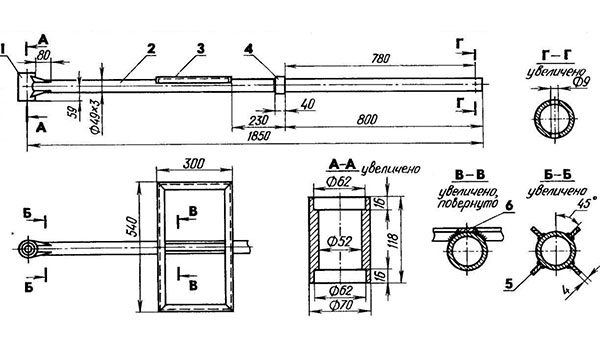
The adapter for the walk-behind tractor consists of the following structural elements:
- The frame is built central or staircase. Suitable materials are metal pipes and corners. The design model must include a fork and bushing that will ensure free rotation of the trailer. There are converted vehicles in which the aggregate device and the trailer are combined. In this option, you should make a new stand for the transmission and engine.
- Suspension systems can be axial, bridge, rotary, portal. It is constructed without the use of elastic fragments.
- A steel sheet is used for the body.
- The hitch is an important element of the converter; it makes the walk-behind tractor stable and securely connected. The coupling unit is made of a 15 cm pin.
- The seat is the driver's workplace.
- The steering is used with a rigid connection. You can build it with your own hands or purchase it in a special store. Craftsmen install steering rods and racks from a VAZ or Volga car.
Types of adapters for walk-behind tractors
There are several types of adapters for mini tractors, including homemade ones.
- With lifting lever. The presented type of suspended equipment will simplify control and movement around the site.
- For transporting goods. They are equipped with special bodies that can withstand maximum loads.
- With long or short drawbar. The short type is for a lightweight type, the long type is for a heavy mechanism.
- With telescopic drawbar. This design allows for width adjustment.
Motoblock device
In terms of its design, the 4x4 adapter, which is designed for the Neva walk-behind tractor, is a rather simple device. It includes several fundamental parts:
- frame structure on which other components can be installed;
- driver's seat;
- wheelbase, including wheel axle;
- the mechanism for connecting the walk-behind tractor, including.
In other words, the adapter is an ordinary cart with a seat that is connected to a walk-behind tractor.
Motoblocks come in different brands and designs. Russian users know, for example: Cayman, Foreman, Viking, Crosser, Texas, Patriot and others. After coupling the walk-behind tractor and the adapter, the resulting device can be compared in functionality to a mini-tractor, however, such a comparison is somewhat arbitrary, since the power will remain the same, because there is still only one engine, and it comes from the walk-behind tractor.
Types of adapters for motorcycles
Adapters for walk-behind tractors are divided depending on the method of their attachment.
The following types of devices are distinguished:
- Rear adapter for walk-behind tractor. The hitch is located at the front of the device, so after connection the adapter will be located at the rear of the unit;
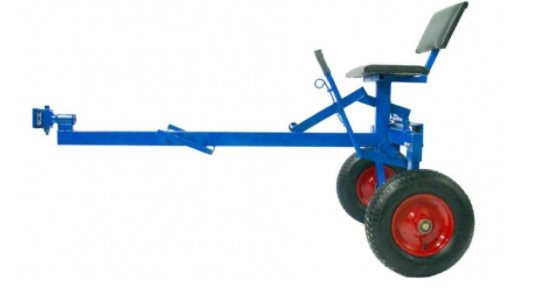
- Front adapter for walk-behind tractor. Accordingly, traction occurs from the rear. The adapter is located in front of the motorcycle and will definitely have a steering wheel for control. Devices with steering control have a more complex design type, and therefore their price on the market is much higher.
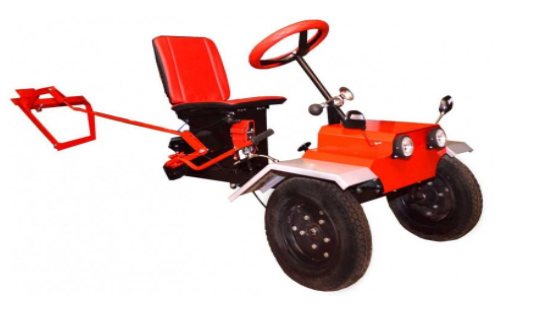
Depending on the area of use, the following adapters are available:
- Shortened . Small in size, which can be used with a light walk-behind tractor. The low weight allows the adapter to be attached directly to the wheel of the unit;
- Elongated. Copes with heavy-duty agricultural machinery. They are distinguished by their significant dimensions and relatively large mass.
Depending on the presence of the body, the following designs are distinguished:
- Bodywork. The existing body allows you to transport various cargo over long distances. They are actively used for everyday tasks and harvesting;
- Bodyless. They are used only for connecting to a walk-behind tractor.
When choosing an adapter, you need to pay attention to the design features of the device. It must fully meet the needs of the owner.
Preparatory stage of adapter manufacturing
The adapter has a simple design, but its manufacturing procedure cannot be called simple. Initially, you need to take into account the drawings and dimensions, which will help you create a device without any defects.
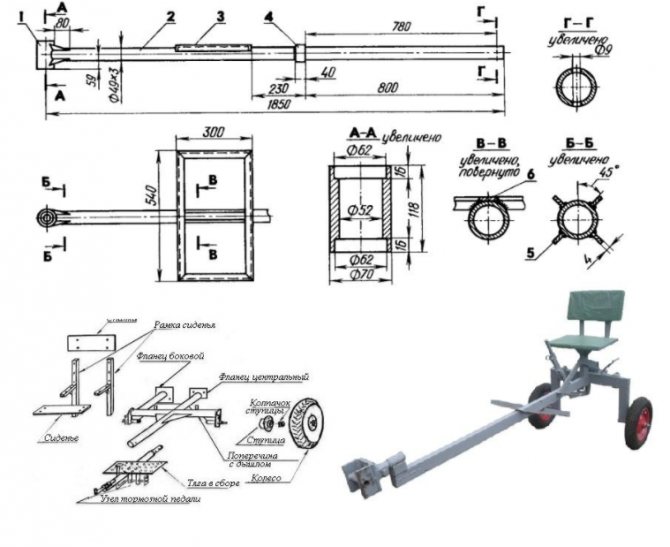
You need to acquire the following materials and tools:
- Electric drill;
- Welding;
- Electric hacksaw;
- File;
- Square;
- Sheet of steel with a thickness of 5 millimeters;
- Several square pipes with a diameter of one inch;
- A set of fastenings.
Key structural elements are manufactured as follows:
- Hitch. Installed on the frame and secured with bolts. The coupling is two welded pieces of square pipes and a piece of water pipe. The latter is inserted into the rod with a welded tee;
- Wheel fixation unit. Two pieces of pipe 10 centimeters long are welded at right angles. The horizontal section is inserted into the mounting pipe and securely fixed with a bolt. An axle and bearings with wheels are attached to a vertical blank.
When all the tools are prepared and the main parts are made, you can assemble the adapter.

